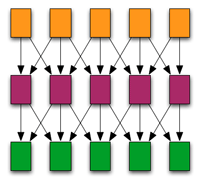How SEO helps with Information Architecture
September 13, 2007 · Chris Peters
In my final part of this series, I would like to talk about how SEO lends a helping hand to Information Architecture.

SEO is indeed related to other user experience disciplines: usability, accessibility, and search usability. In my final part of this series, I would like to talk about how it gives a helping hand to Information Architecture (IA). Strap in for one last look at a more altruistic view of SEO. You may not see anything positive about SEO again for a while!
Speaking your customers’ language, revisited (…again)
I’ve made it a point to tell you repeatedly about the benefits of using the words your customers use. You need to learn about the language your market speaks. Your market is becoming less accepting of your awkwardly huge vocabulary. (Unless you are a part of an open source project and enjoy confusing people to death!)
I believe that this thinking needs to go further than that when you’re building a web site. The information on your web site needs to be organized in a fashion that your customers understand.
Consider this. I recently described how Target organizes its sales floor to a colleague:
Blue World
- Toys
- Electronics
- Camping
- Automotive
- Cards & Gift Accessories
- Bikes
Yellow World
- Clothing
- Shoes
- Accessories
- Jewelry
Green World
- Linens
- Furniture
- Food & Snacks
- Domestic Goods
- Appliances
- Cosmetics
- Pharmacy
Would it be wise for Target to organize their web site into sections for Blue World, Yellow World, and Green World? Would customers get it without thinking much about it? While there is value in Target employees knowing this classification system, I doubt anyone outside this ring would come close to understanding what would be in each world.
So where does SEO come in?
SEO is not the end-all solution to IA problems, but it can help.
If you research the words that your customers look for with tools like Wordtracker and Keyword Discovery, you find out what’s important to your customers. You find out the popularity of search terms in your customers’ own language. You know what to emphasize in your site’s navigation.
If you were on a cookie site looking for chewy cookies, which set of navigation tabs are you going to respond to with the least amount of thought?


I know, I know. Kind of an absurd example, but I’ve seen dumber information architectures! I like how if you’re looking for the word “chewy,” it can’t help but jump out at you in the second example. Go ahead, look at it again and give it a try.
Information architectures are selfish
Have you ever been writing and had trouble deciding which word to use in your sentence?
Should I use “pensive” or “contemplative?” Hmm…
You can run across the same problem when defining your information architecture. You can only choose one word amongst its synonyms. So why not do a little keyword research and just pick the word that your customers use more often? Chances are, they’ll understand it better, and they’ll bite the hook.
Repeating myself yet again
I’ll be a broken record and say that SEO only helps. It doesn’t solve IA problems, but it’s another tool. Think of keyword research as your Ask the Audience lifeline. And really, is usability testing much different?